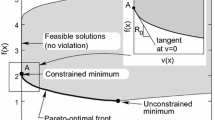Abstract
Constraint normalization ensures consistency in scaling for each constraint in an optimization problem. Most constraint handling studies only address the issue to deal with constraints and use problem information to scale the constraints. In this paper, we propose a hybrid evolutionary algorithm—Constraint Handling with Individual Penalty Approach (CHIP)—which scales all constraints adaptively without any problem specific information from the user. Penalty parameters for all constraints are estimated adaptively by considering overall constraint violation as a helper objective for minimization and as a result any number of constraints can be dealt without incurring proportional computational cost. The efficiency of the proposed method is demonstrated using 23 test problems and two problems from engineering optimization. The constrained optimum and function evaluations of CHIP method are inspected with five recently developed evolutionary-based constraint handling methods. The simulation results show that the proposed CHIP mechanism is very efficient, faster and comparable in the aspect of accuracy against other recently developed methods.












Similar content being viewed by others
References
Ao Y, Chi H (2010) An adaptive differential evolution algorithm to solve constrained optimization problems in engineering design. Engineering 2(1):65–77
Brajevic I (2015) Crossover-based artificial bee colony algorithm for constrained optimization problems. Neural Comput Appl 26(7):1587–1601
Brest J (2009) Constrained real-parameter optimization with \(\varepsilon\) self-adaptive differential evolution. In: Mezura-Montes E (ed) Constraint-handling in evolutionary computation. Springer, Berlin, pp 73–94
Datta R, Deb K (2013) Individual penalty based constraint handling using a hybrid bi-objective and penalty function approach. In: 2013 IEEE congress on evolutionary computation (CEC). IEEE, pp 2720–2727
Datta R, Deb K (2016) Uniform adaptive scaling of equality and inequality constraints within hybrid evolutionary-cum-classical optimization. Soft Comput 20(6):2367–2382
Deb K (2000) An efficient constraint handling method for genetic algorithms. Comput Methods Appl Mech Eng 186(2–4):311–338
Deb K (2001) Multi-objective optimization using evolutionary algorithms. Wiley, Chichester
Deb K, Agrawal S, Pratap A, Meyarivan T (2002) A fast and elitist multi-objective genetic algorithm: NSGA-II. IEEE Trans Evolut Comput 6(2):182–197
Deb K, Datta R (2010) A fast and accurate solution of constrained optimization problems using a hybrid bi-objective and penalty function approach. In: Proceedings of the congress on evolutionary computation (CEC-2010), pp 1–8
Deb K, Datta R (2013) A bi-objective constrained optimization algorithm using a hybrid evolutionary and penalty function approach. Eng Optim 45(5):503–527
Deb K, Lele S, Datta R (2007) A hybrid evolutionary multi-objective and SQP based procedure for constrained optimization. In: Proceedings of the 2nd international conference on advances in computation and intelligence. Springer, pp 36–45
Jordehi AR (2015) A review on constraint handling strategies in particle swarm optimisation. Neural Comput Appl 26(6):1265–1275
Liang JJ, Runarsson TP, Mezura-Montes E, Clerc M, Suganthan PN, Coello CAC, Deb K (2006) Problem definitions and evaluation criteria for the CEC 2006: special session on constrained real-parameter optimization. Technical report, Nanyang Technological University, Singapore
Long W, Liang X, Cai S, Jiao J, Zhang W (2017) A modified augmented Lagrangian with improved grey wolf optimization to constrained optimization problems. Neural Comput Appl 28:1–18
Long W, Liang X, Huang Y, Chen Y (2014) An effective hybrid Cuckoo search algorithm for constrained global optimization. Neural Comput Appl 25(3–4):911–926
Michalewicz Z, Schoenauer M (1996) Evolutionary algorithms for constrained parameter optimization problems. Evolut Comput 4(1):1–32
Myung H, Kim J-H (1999) Multiple Lagrange multiplier method for constrained evolutionary optimization. In: McKay B, Yao X, Newton CS, Kim JH, Furuhashi T (eds) Simulated evolution and learning. Springer, Berlin, pp 2–9
Ray T, Liew K (2003) Society and civilization: an optimization algorithm based on the simulation of social behavior. IEEE Trans Evolut Comput 7(4):386–396
Reklaitis GV, Ravindran A, Ragsdell KM (1983) Engineering optimization methods and applications. Wiley, New York
Riff M-C, Zúñiga M, Montero E (2010) A graph-based immune-inspired constraint satisfaction search. Neural Comput Appl 19(8):1133–1142
Runarsson TP, Yao X (2000) Stochastic ranking for constrained evolutionary optimization. IEEE Trans Evolut Comput 4(3):284–294
Storn R (1999) System design by constraint adaptation and differential evolution. IEEE Trans Evolut Comput 3(1):22–34
Takahama T, Sakai S (2009) Solving difficult constrained optimization problems by the \(\varepsilon\) constrained differential evolution with gradient-based mutation. In: Mezura-Montes E (ed) Constraint-handling in evolutionary computation. Springer, Berlin, pp 51–72
Wang Y, Cai Z (2012) Combining multiobjective optimization with differential evolution to solve constrained optimization problems. IEEE Trans Evolut Comput 16(1):117–134
Zavala A, Aguirre A, Diharce E (2009) Continuous constrained optimization with dynamic tolerance using the COPSO algorithm. In: Mezura-Montes E (ed) Constraint-handling in evolutionary computation. Springer, Berlin, pp 1–23
Zhang M, Luo W, Wang X (2008) Differential evolution with dynamic stochastic selection for constrained optimization. Inf Sci 178(15):3043–3074
Zhao J-Q, Wang L, Zeng P, Fan W-H (2012) An effective hybrid genetic algorithm with flexible allowance technique for constrained engineering design optimization. Expert Syst Appl 39(5):6041–6051
Author information
Authors and Affiliations
Corresponding author
Ethics declarations
Conflict of interest
The authors declare that they have no conflict of interest.
Rights and permissions
About this article
Cite this article
Datta, R., Deb, K. & Kim, JH. CHIP: Constraint Handling with Individual Penalty approach using a hybrid evolutionary algorithm. Neural Comput & Applic 31, 5255–5271 (2019). https://doi.org/10.1007/s00521-018-3364-x
Received:
Accepted:
Published:
Issue Date:
DOI: https://doi.org/10.1007/s00521-018-3364-x




